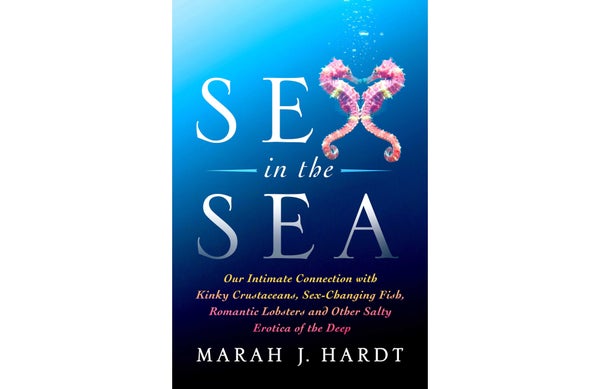Excerpted with permission from Sex in the Sex: Our Intimate Connection with Sex-Changing Fish, Romantic Lobsters, Kinky Squid, and Other Salty Erotica of the Deep, by Marah J. Hardt. Available from St. Martin’s Press. Copyright © 2016. (Scientific American and St. Martin’s Press are part of Holtzbrinck Publishing Group.)
Admittedly, spontaneous sex on the subway is a bit of a stretch (and probably nauseating for anyone who rides the G train on a regular basis). But the idea that sex depends upon a crowd is no exaggeration—especially for the less-than-agile lot.
Take sea urchins. A few leaky males can cause an entire nearby cluster of sea urchins to unleash clouds of sperm, which they pump out through holes in the tops of their heads. As is so often the case, males tend to let loose their loads first, followed by the females. It’s a familiar pattern, occurring in sea cucumbers and abalone, among others. With sea cucumbers—squishy, sausage-shaped cousins of sea stars and sea urchins—researchers think the slight delay between male and female spawning times might help increase fertilization rates. The sperm released by males forms a dense cloud just off the bottom through which the females’ buoyant eggs must float on their way to the surface.
On supporting science journalism
If you're enjoying this article, consider supporting our award-winning journalism by subscribing. By purchasing a subscription you are helping to ensure the future of impactful stories about the discoveries and ideas shaping our world today.
In general, bottom-dwelling, or benthic, invertebrates such as sea cucumbers, sea stars, and sea urchins don’t tend to travel very far, certainly not when compared with migrating bluefin, but even compared with horseshoe crabs. (Deep-sea species may be an exception, as they have to scavenge across fair distances for sparse food supplies.) But around coastal and shallow seas, many invertebrates stick close to home—tubed feet can only take you so far. When it’s time to have sex, these species huddle up with their neighbors as individuals broadcast millions (sometimes billions) of sperm and eggs into the currents.
In an ironic twist, this strategy for boosting fertilization success can also pose a significant threat: even in the enormous expanse of sea, there can be such a thing as too much sperm. For most eggs in the animal kingdom, polyspermy—multiple sperm penetrating an egg—is fatal (those choosey female Beroë ctenophores are a rare exception). To understand what’s going on, we’ve got to dive down to the microscopic front line where sperm meets egg. The battle of the sexes rages on even at this unicellular level, and, believe it or not, sea urchins are the go-to animal for studying this kind of stuff. An extremely diverse group, sea urchins can be the size of a small brown bur or enormous, such as the softball-sized, long-spined black sea urchins, which wield four- to twelve-inch needlelike spines. They look more like a medieval weapon than the underwater lawn mowers they truly are. Impressive to behold, disastrous to touch, sea urchins can be found from the shallows to thousands of feet deep, from the warmest tropical seas to the undersea plains of the Arctic Ocean.
Google “sea urchin fertilization” and you’ll find dozens of animations and videos of lone sea urchin sperm finding its way home to an egg. Why the plethora of sea urchin sex tapes? Because studying fertilization in sea urchins makes sense. They are easy to keep in aquaria, spawn on command (a quick injection of potassium chloride, aka sea urchin ejaculation juice, is all it takes), their gametes are easy to collect once in the water, and because fertilization takes place outside the body, it’s much easier to observe and manipulate than, say, inside an elephant. And, not insignificantly, PETA has yet to march on behalf of captive sea urchins.
So, anyone out there who has ever received fertility treatments, any of the hundreds of thousands of couples who have successfully tried IVF, and especially any of the estimated five million or more people who now exist because of such assisted reproductive technology—thank sea urchins. All of those innovations stand on the shoulders of a basic understanding of what actually happens when sperm and egg collide. And we know that from studying sea urchins.
